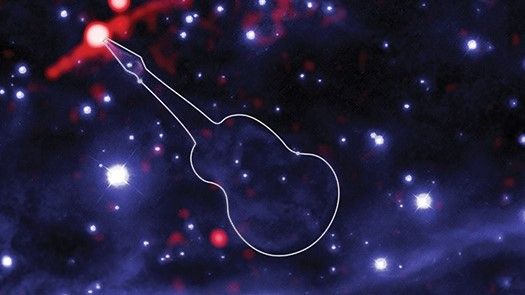NASA telescopes spotted a glowing nebula that looks like a guitar shredding rapid pulses of stellar material through space like sound waves through a packed concert stadium.
The Guitar Nebula is located approximately 2,700 light-years from Earth. The shape of the nebula, or giant cloud of dust and gas, resembles a guitar with a rapidly rotating neutron star (also known as a pulsar) at the tip of the headstock, earning the cosmic structure the nickname “flame-throwing guitar.”
Observations from NASA’s Chandra X-ray Observatory and Hubble Space Telescope show how the nebula and the pulsar, formally known as PSR B2224+65, have changed over more than two decades, according to a new statement from the space agency.
Nebulas often contain the remnants of dying stars stemming from events like supernova explosions. For example, a pulsar is an extremely small, dense and rotating neutron star left over from a massive star that once collapsed and exploded in a supernova. Aptly named, pulsars emit regular pulses of radiation out into their surroundings.
This particular nebula’s faint, guitar-looking shape can be seen by tracing upward from the round body to the pointed headstock, where a bright white dot (representing the pulsar) is connected to the red flame-like filament. The nebula’s unique shape has formed over time from bubbles being blown through a steady wind of particles ejected by the pulsar as it moves through the interstellar medium.
Pulsars have high magnetic fields, along which particles spiral and emit X-rays that can be detected by Chandra. This subject’s X-ray data — shown in red in the new composite image — captures a filament of energetic matter and antimatter particles stretching about two light-years, or 12 trillion miles (19.3 trillion kilometers), from the pulsar located near the top of the Guitar Nebula.
“As the pulsar and its surrounding nebula of energetic particles have flown through space, they have collided with denser regions of gas,” NASA officials said in the statement. “This allows the most energetic particles to escape the confines of the Guitar Nebula and fly to the right of the pulsar, creating the filament of X-rays. When those particles escape, they spiral around and flow along magnetic field lines in the interstellar medium, that is, the space in between stars.”
Researchers used data obtained by Chandra between 2000 and 2021, along with Hubble observations between 1994 and 2021, to study the formation of the nebula and better understand how pulsars interact with the space between stars. Their findings were the focus of a study previously published in Nov. 2022 in The Astrophysical Journal.

